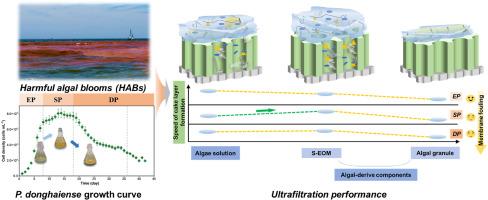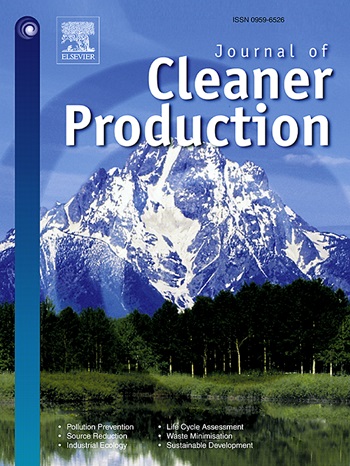Understanding the fouling characteristics in ultrafiltration membrane for marine algae-laden seawater pretreatment: Focus on the role of algal extracellular organic matter
IF 9.7
1区 环境科学与生态学
Q1 ENGINEERING, ENVIRONMENTAL
引用次数: 0
Abstract
The increasing frequency and extent of harmful algal blooms (HABs) due to global warming and environmental pollution pose significant challenges to the ultrafiltration (UF)-seawater reverse osmosis (SWRO) desalination process. The UF process is a dominant pretreatment method to reduce HAB fouling potential in subsequent SWRO processes. Herein, we systematically evaluate the UF membrane fouling characteristics at different growth phases of HAB algae in terms of reversible/irreversible fouling and pinpoint the fouling mechanisms on UF membranes in the real seawater matrix. We employed Prorocentrum donghaiense as a model marine HAB specie to characterize algal derivatives, including extracellular organic matter (EOM) and granule particles. LC-OCD, MFIs, 3D-EEM, and GPC were used to analyze algae-derived matters. Results from the multiple fouling model revealed that algal solution in both stationary and decline phases exhibit severe membrane fouling, characterized by rapid cake layer formation, swift flux decline, and high membrane resistance. Soluble EOM (S-EOM) was the primary contributor to membrane fouling, linked to its elevated concentrations of dissolved organic matters, polysaccharides, proteins, and humic substances, which are predominantly hydrophobic. Additionally, granule particles mitigated organic membrane fouling, as evidenced by the smaller permeate volume required for S-EOM cake layer formation (<5 mL), resulting in a faster initial flux decline. These results revealed a shift in released organic matter from protein-centric to humic substance-centric during the transition from exponential growth to the decline phase, with correlation analysis further underscoring the substantial contribution of humic substances to membrane resistance. This research highlights the distinct UF membrane fouling characteristics at different marine algal growth stages, offering theoretical support for predicting and managing HABs.

了解超滤膜在含海藻海水预处理中的污垢特性:关注藻类胞外有机物的作用
由于全球变暖和环境污染,有害藻华(HAB)的发生频率和范围不断增加,这给超滤(UF)-海水反渗透(SWRO)海水淡化工艺带来了巨大挑战。超滤工艺是一种主要的预处理方法,可降低 HAB 在后续 SWRO 工艺中造成污垢的可能性。在此,我们从可逆/不可逆污垢方面系统地评估了 HAB 藻类在不同生长阶段的超滤膜污垢特性,并指出了在真实海水基质中超滤膜的污垢机制。我们以东海螺(Prorocentrum donghaiense)为模式海洋 HAB 藻类,研究了藻类衍生物的特征,包括胞外有机物(EOM)和颗粒物。使用 LC-OCD、MFIs、3D-EEM 和 GPC 分析藻类衍生物质。多重污垢模型的结果表明,藻类溶液在固定相和衰退相均表现出严重的膜污垢,其特点是滤饼层形成快、通量下降快、膜阻力大。可溶性 EOM(S-EOM)是造成膜堵塞的主要原因,这与它含有高浓度的溶解有机物、多糖、蛋白质和腐殖质有关,而这些物质主要是疏水性的。此外,颗粒粒子减轻了有机膜堵塞,这从 S-EOM 滤饼层形成所需的渗透体积较小(5 mL),导致初始通量下降较快可以看出。这些结果表明,在从指数增长到下降阶段的转变过程中,释放的有机物从以蛋白质为中心转变为以腐殖质为中心,相关分析进一步强调了腐殖质对膜阻力的重大贡献。这项研究强调了超滤膜在不同海洋藻类生长阶段的不同污垢特征,为预测和管理有害藻类繁殖提供了理论支持。
本文章由计算机程序翻译,如有差异,请以英文原文为准。
求助全文
约1分钟内获得全文
求助全文
来源期刊

Journal of Cleaner Production
环境科学-工程:环境
CiteScore
20.40
自引率
9.00%
发文量
4720
审稿时长
111 days
期刊介绍:
The Journal of Cleaner Production is an international, transdisciplinary journal that addresses and discusses theoretical and practical Cleaner Production, Environmental, and Sustainability issues. It aims to help societies become more sustainable by focusing on the concept of 'Cleaner Production', which aims at preventing waste production and increasing efficiencies in energy, water, resources, and human capital use. The journal serves as a platform for corporations, governments, education institutions, regions, and societies to engage in discussions and research related to Cleaner Production, environmental, and sustainability practices.
 求助内容:
求助内容: 应助结果提醒方式:
应助结果提醒方式:


